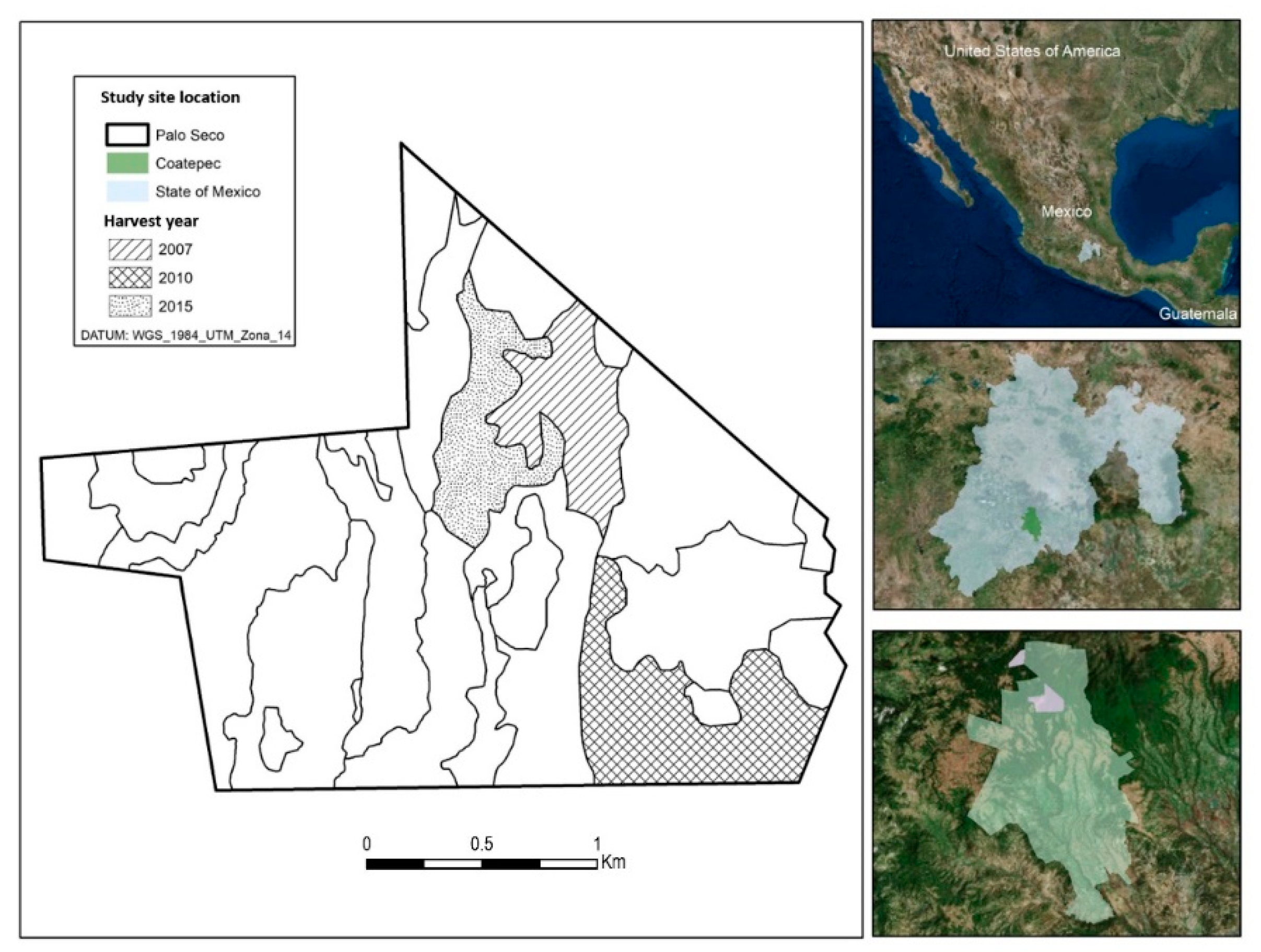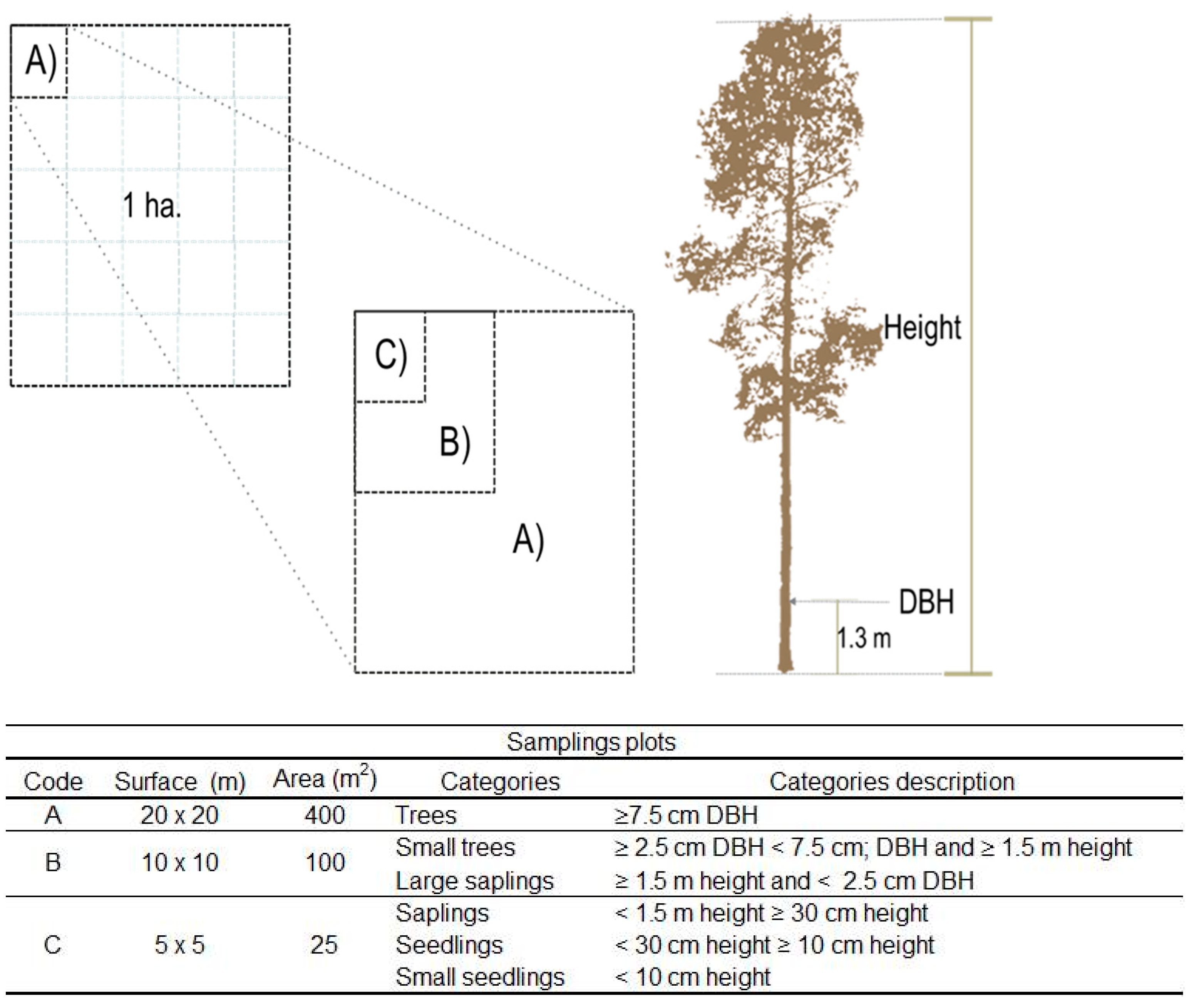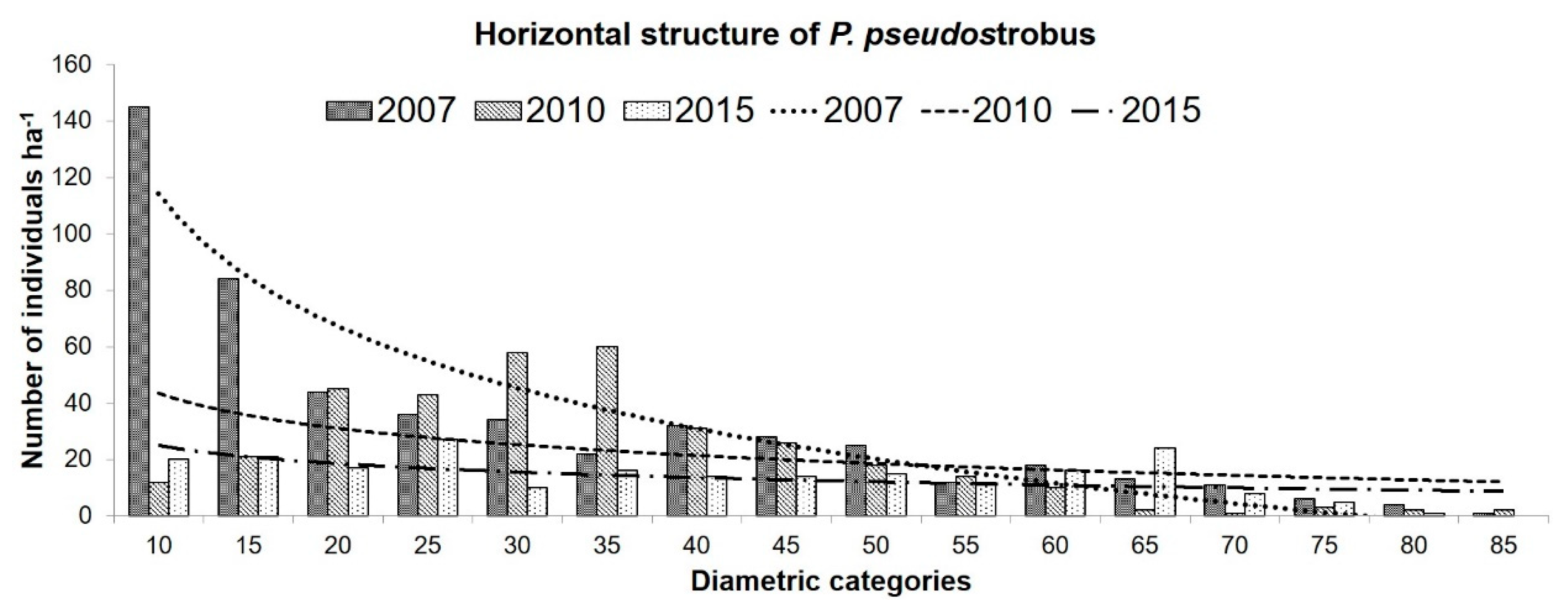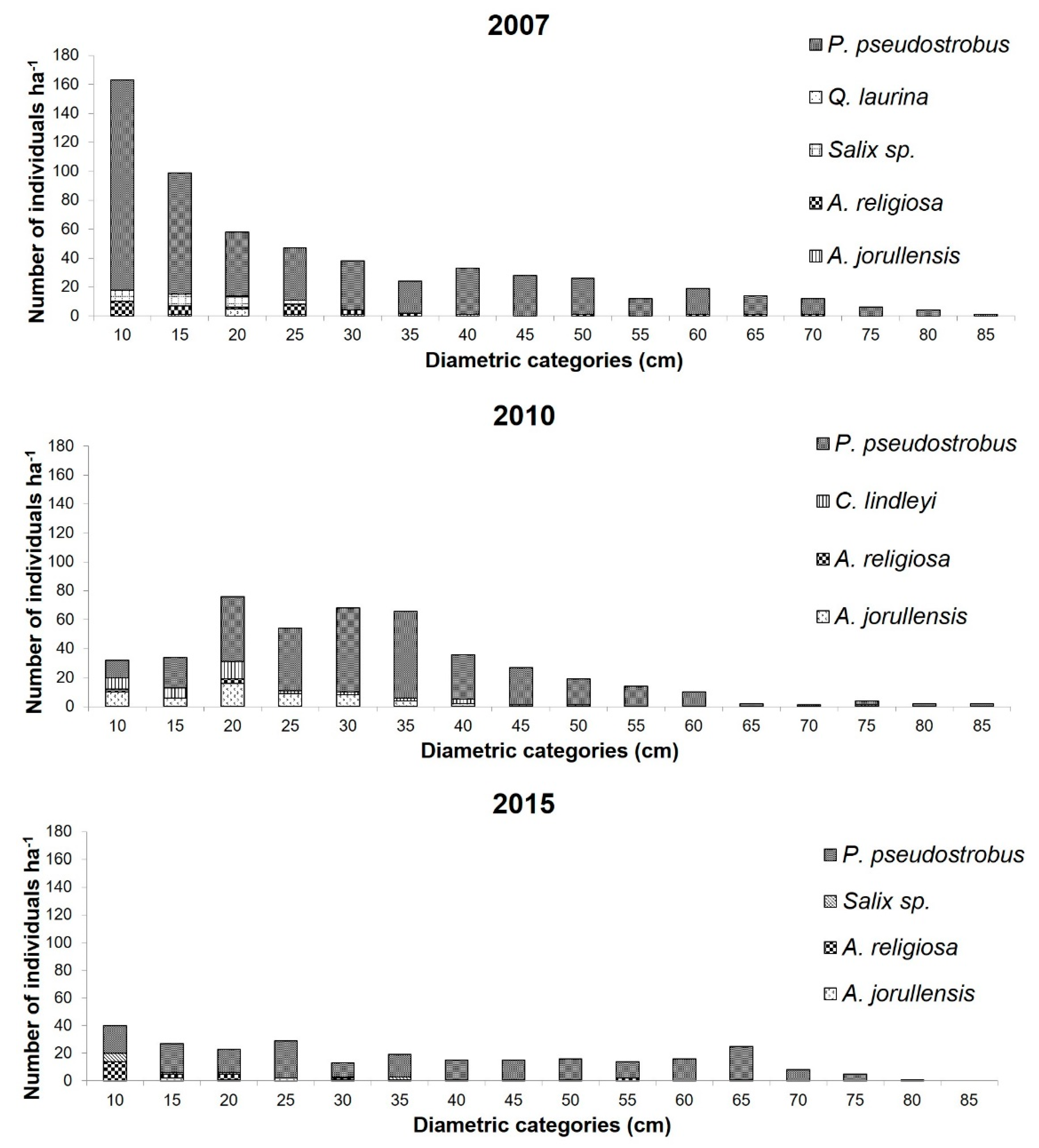Forest Harvesting Impacts on the Structure and Composition of Coniferous Forests in Mexico
Abstract
1. Introduction
2. Materials and Methods
2.1. Study Site
Experimental Design
2.2. Sampling Plots
2.3. Species Composition and Diversity
2.4. Tree Canopy Structure
3. Results
3.1. Species Composition and Diversity
3.2. Tree Canopy Structure
3.2.1. Horizontal Structure
3.2.2. Vertical Structure
3.3. Forest Regeneration
4. Discussion
4.1. Species Composition
4.2. Tree Canopy Structure
5. Conclusions
Author Contributions
Funding
Data Availability Statement
Acknowledgments
Conflicts of Interest
References
- Aguirre, C.O.A. Manejo Forestal en el Siglo XXI. For. Ambiente 2015, 21, 17–28. [Google Scholar]
- MacDicken, K.G. Global Forest Resources Assessment 2015: What, why and how? For. Ecol. Manag. 2015, 352, 3–8. [Google Scholar] [CrossRef]
- Cubbage, F.; Diaz, D.; Yapura, P.; Dube, F. Impacts of forest management certification in Argentina and Chile. For. Policy Econ. 2010, 12, 497–504. [Google Scholar] [CrossRef]
- Wunder, S.; Wertz-Kanounnikoff, S.; Moreno-Sánchez, R. Pago por servicios ambientales: Una nueva forma de conservar la biodiversidad. Gaceta Ecológica 2007, 84–85, 39–52. [Google Scholar]
- Keenan, R.J.; Reams, G.A.; Achard, F.; de Freitas, J.V.; Lindquist, G.E. Dynamics of global forest area: Results from the FAO Global Forest Resources Assessment 2015. For. Ecol. Manag. 2015, 352, 9–20. [Google Scholar] [CrossRef]
- Villegas, Z.; Peña-Claros, M.; Mostacedo, B.; Alarcón, A.; Licona, J.C.; Leaño, C.; Pariona, W.; Choque, U. Silvicultural treatments enhance growth rates of future crop trees in a tropical dry forest. For. Ecol. Manag. 2009, 258, 971–977. [Google Scholar] [CrossRef]
- Hernández-Salas, J.; Aguirre, O.; Alanís, E.; Jiménez, J.; González, M.A. Efecto del manejo forestal en la diversidad y composición arbórea de un bosque templado del noroeste de México. Rev. Chapingo Ser. Cienc. For. Ambiente 2013, 19, 189–199. [Google Scholar] [CrossRef]
- Hernández, L.I. Cambios en la Estructura y Composición del Bosque bajo dos Tratamientos Silviculturales en la Comunidad de Capulálpan de Méndez, Ixtlán, Oaxaca, México. Master‘s Thesis, CATIE, Turrialba, Costa Rica, 2007; p. 100. [Google Scholar]
- Kuuluvainen, T. Gap disturbance, ground microtopography, and the regeneration dynamics of boreal coniferous forests in Finland: A review. Ann. Zool. Fennici. 1994, 31, 35–51. [Google Scholar]
- Chediack, S.E. Efecto de la explotación forestal sobre la estructura, diversidad y composición florística de los palmitales de la Selva Atlántica en Misiones, Argentina. Rev. Biol. Trop. 2008, 56, 721–738. [Google Scholar]
- Bonilla-Luna, N.; Cuesta-Córdova, H.; Valois-Cuesta, H. Efectos de la extracción forestal sobre la estructura y composición de un bosque pluvial del Pacífico colombiano. Rev. Biodivers. Neotrop. 2011, 1, 48–54. [Google Scholar] [CrossRef][Green Version]
- Fredericksen, T.S.; Putz, F.E. Silvicultural intensification for tropical forest conservation. Biodivers. Conserv. 2003, 12, 1445–1453. [Google Scholar] [CrossRef]
- Corral, R.J.J.; Aguirre, O.A.; Jiménez, P.J.; Corral, R.S. Un análisis del efecto del aprovechamiento forestal sobre la diversidad estructural en el bosque mesófilo de montaña “El Cielo”, Tamaulipas, México. Investig. Agrícola Sist. Recur. For. 2005, 14, 217–228. [Google Scholar]
- Gadow, K.; Sánchez, O.S.; Aguirre, C.O.A. Manejo forestal con bases científicas. Madera Bosques 2004, 10, 3–16. [Google Scholar] [CrossRef]
- Barrette, M.; Bélanger, L.; De Grandpré, L.; Royo, A.A. Demographic disequilibrium caused by canopy gap expansion and recruitment failure triggers forest cover loss. For. Ecol. Manag. 2017, 401, 117–124. [Google Scholar] [CrossRef]
- Veblen, T.T.; Kitzberger, T.; Lara, A. Disturbance and forests dynamics along a transect from Andean rain forest to Patagonian shrubland. J. Veg. Sci. 1992, 3, 507–520. [Google Scholar] [CrossRef]
- López-Hernández, J.A.; Aguirre-Calderón, O.A.; Alanís-Rodríguez, E.; Monarrez-González, J.C.; González-Tagle, M.A.; Jimenéz-Pérez, J. Composición y diversidad de especies forestales en bosques templados de Puebla, México. For. Ambiente 2017, 23, 39–51. [Google Scholar] [CrossRef]
- Motz, K.; Sterba, H.; Pommerening, A. Sampling measures of tree diversity. For. Ecol. Manag. 2010, 260, 1985–1996. [Google Scholar] [CrossRef]
- Guzmán-Gutiérrez, R.A. Caracterización y Clasificación de Especies Forestales en Gremios Ecológicos en el Bosque Sub-Húmedo Estacional de la Región de Lomerío, Santa Cruz, Bolivia. Master’s Thesis, CATIE, Turrialba, Costa Rica, 1997; p. 59. [Google Scholar]
- Ramos, B.Z.S. Estructura y Composición de un Paisaje Boscoso Fragmentado: Herramienta Para el Diseño de Estrategias de Conservación de la Biodiversidad. Master’s Thesis, CATIE, Turrialba, Costa Rica, 2004; p. 114. [Google Scholar]
- Rozas, V. Dinámica forestal y tendencias sucesionales en un bosque maduro de roble y haya de la zona Central de la Cornisa Cantábrica. Ecología 2001, 15, 179–211. [Google Scholar]
- Bergeron, Y.; Harvey, B. Basing silviculture on natural ecosystem dynamics: An approach applied to the southern boreal mixed forest of Quebec. For. Ecol. Manag. 1997, 92, 235–242. [Google Scholar] [CrossRef]
- Louman, B.; Quirós, D.; Nilsson, M. Silvicultura de Boques Latifoliados Húmedos con Énfasis en América Central; Turrialba, C.R., Ed.; CATIE: Turrialba, Costa Rica, 2001; p. 269. [Google Scholar]
- Del Río, M.; Montes, F.; Cañellas, I.; Montero, G. Revisión: Índices de diversidad estructural en masas forestales. Investig. Agrar. Sist. Recur. For. 2003, 12, 159–176. [Google Scholar]
- Challenger, A.; Soberón, J. Los Ecosistemas Terrestres, En Capital Natural de México, Vol I: Conocimiento Actual de la Biodiversidad; CONABIO: México City, México, 2008; pp. 87–108. [Google Scholar]
- Torres-Rojo, J.M.; Moreno-Sánchez, R.; Mendoza-Briseño, M.A. Sustainable Forest Management in México. Curr. For. Rep. 2016, 2, 93–105. [Google Scholar] [CrossRef]
- Figueroa-Rangel, B.L.; Willis, J.K.; Olvera-Vargas, M. 4200 years of pine-dominated upland forest dynamics in west-central Mexico: Human or natural legacy? Ecology 2008, 89, 1893–1907. [Google Scholar] [CrossRef]
- Merino, L.; Martínez, A.E. A Vuelo de Pájaro: Las Condiciones de las Comunidades con Bosques Templados en México; CONABIO: México City, México, 2014; p. 247. [Google Scholar]
- Endara, A.A.R.; Aguirre, N.A.; López, J.L.; Franco, M.S. Manejo Adaptativo en Bosques de alta Montaña, México; Congreso Forestal Latinoamericano: Lima, Perú, 2011. [Google Scholar]
- Endara-Agramont, A.R.; Calderón-Contreras, R.; Nava-Bernal, G.; Franco-Maass, S. Analysis of Fragmentation Processes in High-Mountain Forests of the Centre of Mexico. Am. J. Plant Sci. 2013, 4, 607–704. [Google Scholar] [CrossRef]
- Granados-Sánchez, D.; López-Ríos, G.F.; Hernández-García, M.A. Ecología y Silvicultura en bosques templados. Rev. Chapingo Ser. Cienc. For. Ambiente 2007, 13, 67–83. [Google Scholar]
- Bocco, G.; Velázquez, A.; Torres, A. Ciencia, comunidades indígenas y manejo de recursos naturales. Caso Investig. Particip. México Interciencia 2000, 25, 64–70. [Google Scholar]
- Demant, A. Características del Eje Neovolcánico Transmexicano y sus Problemas de Interpretación; Universidad Nacional Autónoma de México, Instituto de Geología: México City, México, 1978; Volume 2, pp. 172–187. [Google Scholar]
- Sola, G.; El Mujtar, V.; Tsuda, Y.; Vendramin, G.G.; Gallo, L. The effect of silvicultural management on the genetic diversity of mixed Nothofagus forest in Lanin Natural Reserve, Argentina. For. Ecol. Manag. 2016, 363, 11–20. [Google Scholar] [CrossRef]
- Endara, A.A.R.; Franco, M.S.; Nava, B.G.; Valdez, H.J.I.; Fredericksen, T.S. Effect of human disturbance on the structure and regeneration of forests in the Nevado de Toluca National Park, Mexico. J. For. Res. 2012, 23, 39–44. [Google Scholar] [CrossRef]
- Ramos, C.; Simonetti, J.A.; Flores, J.D.; Ramos-Jiliberto, R. Modeling the management of fragmented forests: Is it possible to recover the original tree composition? The case of the Mauilino forest in Central Chile. For. Ecol. Manag. 2008, 255, 2236–2243. [Google Scholar] [CrossRef]
- Onaindia, M.; Dominguez, I.; Albizu, I.; Garbisu, C.; Amezaga, I. Vegetation diversity and vertical structure as indicators of forest disturbance. For. Ecol. Manag. 2004, 195, 34–354. [Google Scholar] [CrossRef]
- Dalle, S.P.; de Blois, S.; Caballero, J.; Johns, T. Integrating analyses of local land-use regulations, cultural perceptions and land-use/land-cover data for assessing the success of community-based conservation. For. Ecol. Manag. 2006, 222, 370–383. [Google Scholar] [CrossRef]
- Solis, M.R.; Aguirre, C.O.A.; Treviño, G.E.J.; Jiménez, P.J.; Jurado, Y.E.; Corral-Rivas, J. Efecto de dos tratamientos silvícolas en la estructura de ecosistemas forestales en Durango, México. Madera Bosques 2006, 12, 49–64. [Google Scholar] [CrossRef][Green Version]
- Bauhus, J.; Puettmann, K.; Messier, C. Silviculture for old-growth attributes. For. Ecol. Manag. 2009, 258, 525–537. [Google Scholar] [CrossRef]
- Pagdee, A.; Kim, Y.; Daugherty, P. What makes community forest management successful: A meta-study from community forests throughout the world. Soc. Nat. Resour. 2006, 19, 33–52. [Google Scholar] [CrossRef]
- Pérez, M.R.; Moreno, S.F.; González, H.A.; Arreola, P.V. Escenarios de la distribución potencial de Pinus patula Schltdl. et Cham. y Pinus pseudostrobus Lindl. con modelos de cambio climático en el Estado de México. Rev. Mex. Cienc. For. 2013, 4, 73–86. [Google Scholar]
- Ignacio-Ruiz, N.; Rangel-Villafranco, M.; Cárdenas-Camargo, I. Estructura del bosque y propagación de dos especies de encinos con micorrizas en el Estado de México. Rev. Iberoam. Cienc. 2014, 1, 136–144. [Google Scholar]
- Endara, A.A.R.; Herrera, T.F. Deterioro y conservación de los bosques del Nevado de Toluca y el rol de los actores locales. Cienc. Ergo-Sum. 2016, 23, 247–254. [Google Scholar]
- Arce, J.L.; Macías, J.L.; Vázquez-Selem, L. The 10.5 ka Plinian eruption of Nevado de Toluca volcano, Mexico: Stratigraphy and hazard implications. Geol. Soc. Am. Bull. 2003, 115, 230–248. [Google Scholar] [CrossRef]
- Sotelo, E.G.E.; Cruz, G.M.F.; Ochoa, S. La Clasificación FAO-WRB y los Suelos del Estado de México; Instituto Nacional de Investigaciones Forestales: Agrícolas y Pecuarias, México, 2010. [Google Scholar]
- Valdez, H.J.I. Aprovechamiento forestal de manglares en el estado de Nayarit Costa Pacífica de México. Madera Bosques 2002, 1, 129–145. [Google Scholar]
- Lampretch, H. Silvicultura en los Trópicos: Dinámica de los Bosques Tropicales Húmedos. Deutsche Gesellschaft für Technische Zusammernarbeit; Instituto de Silvicultura de la Universidad de Gottingen: Gottingen, Germany, 1990. [Google Scholar]
- Magurran, A.E. Measuring Biological Diversity; Blackwell Science Ltd.: Victoria, Australia, 2004; p. 215. [Google Scholar]
- Danková, L.; Saniga, M. Canopy gaps and tree regeneration patterns in multi-species unmanaged natural forest Sitno (Preliminary results). Beskydy 2013, 6, 17–26. [Google Scholar] [CrossRef]
- Fredericksen, T.; Contreras, F.; Pariona, W. Guía de Silvicultura Para Bosques Tropicales de Bolivia; Proyecto de Manejo Forestal Sostenible BOLFOR: Santa Cruz, Bolivia, 2001; p. 82. [Google Scholar]
- Torras, O.; Saura, S. Effects of silvicultural treatments on forest biodiversity indicators in the Mediterranean. For. Ecol. Manag. 2008, 255, 3322–3330. [Google Scholar] [CrossRef]
- Torras, O.; Gil-Tena, A.; Saura, S. Changes in biodiversity indicators in managed and unmanaged forest in NE Spain. J. For. Res. 2012, 17, 19–29. [Google Scholar] [CrossRef]
- Justiniano, M.J.; Fredericksen, T.S. Phenology of Tree Species in Bolivian dry Forests. Biotropica 2000, 32, 276–281. [Google Scholar] [CrossRef]
- Perry, J.P.; Graham, A.; Richardson, D.M. The history of pines in Mexico and Central America. In Ecology and Biogeography of Pinus; Richardson, D.M., Ed.; Cambridge University Press: Cambridge, UK, 1998; pp. 137–149. [Google Scholar]
- Weber, T.A.; Hart, J.L.; Schweitzer, C.J.; Dey, D.C. Influence of gap-scale disturbance on developmental and successional pathways in Quercus-Pinus stands. For. Ecol. Manag. 2014, 331, 60–70. [Google Scholar] [CrossRef]
- Jiménez, J.; Aguirre, O.; Kramer, H. Análisis de la estructura horizontal y vertical en un ecosistema multicohortal de pino-encino en el norte de México. Sist. Recur. For. 2001, 10, 355–366. [Google Scholar]
- Sáenz-Romero, C.; Rehfeldt, G.E.; Duval, P.; Linding-Cisneros, R.A. Abies religiosa habitat prediction in climatic change scenarios and implications for monarch butterfly conservation in Mexico. For. Ecol. Manag. 2012, 275, 98–106. [Google Scholar] [CrossRef]
- Sáenz-Romero, C.; Rehfeldt, G.E.; Soto-Correa, J.C.; Aguilar-Aguilar, S. Zamarripa-Morales, V.; López-Upton, J. Altitudinal Genetic variation among Pinus pseudostrobus populations from Michoacán, Mexico. Two locations shadehouse test results. Rev. Fitotec. Mex. 2012, 35, 111–120. [Google Scholar]
- López-Upton, J. Pinus pseudostrobus Lindl. In Tropical Tree Seed Manual; Vozzo, J.A., Ed.; USDA Forest Service: St. Paul, MN, USA, 2002; p. 889. [Google Scholar]
- López-Sánchez, C.L.; Bolívar-Cimé, B.; Aparicio-Rentería, A.; Viveros-Viveros, H. Population structure of Alnus jorullensis, a species used as firewood by five rural communities in a natural protected area of Mexico. Bot. Sci. 2020, 98, 238–247. [Google Scholar] [CrossRef]
- Villas, S.A.; Alonso, R.M. Una contribución al conocimiento de los sauces en México. Rev. Mex. Cienc. For. 1995, 20, 35–65. [Google Scholar]
- Castellanos-Bolaños, J.F.; Treviño-Garza, E.J.; Aguirre-Calderón, O.A.; Jiménez-Pérez, J.; Musálem-Santiago, M.; López-Aguillón, R. Estructura de bosques de Pinus patula bajo manejo en Ixtlán de Juárez, Oaxaca, México. Madera Bosques 2008, 14, 51–63. [Google Scholar] [CrossRef]
- Navarro, F.B.; Jiménez, M.N.; Cañadas, E.M.; Gallego, E.; Terrón, L.; Ripoll, M.A. Effects of different intensities of overstory thinning on tree growth and understory plant-species productivity in a semi-arid Pinus halepensis Mill. afforestation. Forest. Syst. 2010, 19, 410–417. [Google Scholar] [CrossRef]
- Mostacedo, B.; Peña, M.; Rumiz, D.; Villegas, Z. Hacia un Modelo de Manejo Sostenible del Bosque Seco Chiquitano; Propuesta de ajustes a ciertas prácticas forestales; FCBC: Santa Cruz de la Sierra, Bolivia, 2010. [Google Scholar]
- Diario Oficial de la Federación (DOF). Reglamento de la Ley General de Desarrollo Forestal Sustentable; DOF: México City, México, 2005. [Google Scholar]
- Diario Oficial de la Federación (DOF). Norma Oficial Mexicana NOM-152-SEMARNAT-2006, Que Establece los Lineamientos, Criterios y Especificaciones de los Contenidos de los Programas de Manejo Forestal Para el Aprovechamiento de Recursos Forestales Maderables en Bosques, Selvas y Vegetación de Zonas Áridas; DOF: México City, México, 2008. [Google Scholar]
- Ramírez, M.J.J. Aprovechamiento y Manejo Silvícola de los Recursos Forestales en Seis Municipios de la Región Oeste del Estado de Jalisco. Bachelor Thesis, Universidad Autónoma Agraria Antonio Narro, Saltillo, México, 1998; p. 34. [Google Scholar]
- Fredericksen, T.S. Aprovechamiento Forestal y Conservación de los Bosques Tropicales en Bolivia; Proyecto de Manejo Forestal Sostenible BOLFOR: Santa Cruz, Bolivia, 2000; p. 22. [Google Scholar]
- BOLFOR. Normas Técnicas Para la Elaboración de Instrumentos de Manejo Forestal (Inventarios, Planes de Manejo, Planes Operativos, mapas) en Propiedades Privadas o Concesiones con Superficies Mayores a 200 Hectáreas; Resolución Ministerial No. 62/97; BOLFOR: La Paz, Bolivia, 1997. [Google Scholar]
- Figueres-Olsen, J.M.; Castro-Salazar, R. Reglamento a la Ley Forestal. Ley Forestal No. 7575. La Gaceta No. 16. 23 de enero de 1997; San José, Costa Rica, 1997; p. 32. Available online: https://www.google.com.hk/url?sa=t&rct=j&q=&esrc=s&source=web&cd=&ved=2ahUKEwikwKyk3qXyAhUgyIsBHQuJDRMQFnoECAIQAQ&url=http%3A%2F%2Fwww.da.go.cr%2Fwp-content%2Fuploads%2F2016%2F06%2FDecreto-Reglamento-Ley-Forestal-DE-25721-MINAE.pdf&usg=AOvVaw2NJs1gbl0Rc4W6wV0g7oil (accessed on 11 May 2021).
- Dauber, E.; Fredericksen, T.S.; Peña-Claros, M. Sustainability of timber harvesting in Bolivian tropical forests. For. Ecol. Manag. 2005, 214, 294–304. [Google Scholar] [CrossRef]





| Management Years | ||||||||||||
|---|---|---|---|---|---|---|---|---|---|---|---|---|
| 2007 | 2010 | 2015 | IVI | |||||||||
| Species | Ar | Dr | Fr | Ar | Dr | Fr | Ar | Dr | Fr | 2007 | 2010 | 2015 |
| Pinus pseudostrobus | 88.1 | 93.4 | 100 | 76 | 88.5 | 100 | 82 | 93.4 | 100 | 281.5 | 264.5 | 275.4 |
| Abies religiosa | 5.65 | 2.12 | 52 | 1.1 | 0.28 | 20 | 10 | 4.34 | 64 | 59.77 | 21.38 | 78.34 |
| Alnus jorullensis | 1.54 | 0.85 | 16 | 12 | 6.63 | 80 | 2.6 | 1.17 | 16 | 10.38 | 98.63 | 19.77 |
| Salix sp. | 4.45 | 1.24 | 52 | 1.1 | 0.15 | 8 | 4.1 | 0.93 | 16 | 57.69 | 9.25 | 21.03 |
| Quercus laurina | 0.17 | 0.06 | 4 | 0.9 | 0.08 | 4 | 0.7 | 0.15 | 8 | 4.23 | 4.98 | 8.85 |
| Cupressus lindleyi | - | - | - | 8.1 | 4.32 | 8 | - | - | - | - | 20.42 | - |
| Simpson Index Before Forest Harvesting | |||||
|---|---|---|---|---|---|
| Year 2007 | |||||
| n | pi2 | N | D | 1-D | |
| A. jorullensis | 9 | 0.000205 | 593 | 0.78572 | 0.2142849 |
| A. religiosa | 33 | 0.003008 | |||
| P. pseudostrobus | 524 | 0.78065 | |||
| Q. laurina | 1 | 0 | |||
| Salix sp. | 26 | 0.001852 | |||
| Year 2010 | |||||
| A. jorullensis | 59 | 0.015792 | 466 | 0.60867 | 0.3913332 |
| A. religiosa | 5 | 0.0000923 | |||
| C. lindleyi | 37 | 0.0061470 | |||
| I. discolor | 2 | 0.0000092 | |||
| P. pseudostrobus | 357 | 0.5865153 | |||
| Q. laurina | 4 | 0.0000554 | |||
| Salix sp. | 4 | 0.0000554 | |||
| Year 2015 | |||||
| A. jorullensis | 7 | 0.000578 | 270 | 0.68804 | 0.3119648 |
| A. religiosa | 28 | 0.010409 | |||
| P. pseudostrobus | 222 | 0.675506 | |||
| Q. laurina | 2 | 0.0000275 | |||
| Salix sp. | 11 | 0.0015145 | |||
| P. pseudostrobus | Salix sp. | C. mexicana | A. jorullensis | A. religiosa | C. lindleyi | ||||
|---|---|---|---|---|---|---|---|---|---|
| Diametric Category | 2007 | 2010 | 2015 | 2010 | 2015 | 2015 | 2015 | 2015 | 2010 |
| (cm) | Harvesting Per Category (%) | ||||||||
| 10 | 2.68 | 69.23 | 9.09 | 33.33 | 14.29 | 100.00 | 100.00 | 6.67 | 11.11 |
| 15 | 11.58 | 54.35 | 12.50 | 50.00 | 75.00 | 100.00 | 33.33 | 0.00 | 0.00 |
| 20 | 26.67 | 51.09 | 19.05 | 0.00 | 0.00 | 100.00 | 95.24 | 0.00 | 0.00 |
| 25 | 12.20 | 18.87 | 12.90 | - | 100.00 | - | 33.33 | - | 0.00 |
| 30 | 24.44 | 25.64 | 33.33 | - | 0.00 | - | 0.00 | 0.00 | 0.00 |
| 35 | 31.25 | 7.69 | 36.00 | - | 33.33 | - | - | 0.00 | 0.00 |
| 40 | 33.33 | 24.39 | 50.00 | - | 100.00 | - | - | 0.00 | 0.00 |
| 45 | 20.00 | 10.34 | 30.00 | - | 100.00 | - | 0.00 | - | - |
| 50 | 28.57 | 30.77 | 42.31 | - | - | - | - | 0.00 | - |
| 55 | 42.86 | 17.65 | 47.83 | - | - | - | - | 0.00 | - |
| 60 | 45.45 | 41.18 | 42.86 | - | - | - | - | - | - |
| 65 | 18.75 | 33.33 | 14.29 | - | - | - | 100.00 | 0.00 | - |
| 70 | 31.25 | 87.50 | 42.86 | - | 100.00 | - | - | - | - |
| 75 | 0.00 | 0.00 | 37.50 | - | - | - | - | - | 0.00 |
| 80 | 33.33 | 75.00 | 0.00 | - | - | - | - | - | - |
| 85 | 0.00 | 0.00 | - | - | - | - | - | - | |
| 90 | 100.00 | 100.00 | - | - | - | - | - | - | - |
| 95 | 0.00 | 0.00 | - | - | - | - | - | - | - |
| 100 | 0.00 | 0.00 | 100.00 | - | - | - | - | - | - |
| Ecological Group | Description | Species |
|---|---|---|
| Long-lived shade-intolerant | Shade-intolerant, regenerate in disturbed areas and are long-lived and occupy the canopy. | Aile (Alnus jorullensis) Cedro blanco (Cupressus lindleyi) |
| Partial shade-tolerant | Partially tolerant of shade, but depend on gap formation for growth and occupy the canopy. | Oyamel (Abies religiosa) Cucharillo (Clethra mexicana) Capulincillo (Ilex discolor) Encino (Quercus laurina) Pino (Pinus pseudostrobus) Guajote (Salix sp.) |
| Species | Small Seedlings | Seedlings | Saplings | Large Saplings | Small Trees |
|---|---|---|---|---|---|
| Relative Abundance (%) | |||||
| P. pseudostrobus | 94.96 | 78.95 | 72.41 | 38.64 | 47.19 |
| I. discolor | 4.32 | 21.05 | 3.45 | 13.64 | 5.62 |
| A. religiosa | 0.72 | - | 13.79 | 4.55 | 15.73 |
| Salix sp. | - | - | 10.34 | 18.18 | 15.73 |
| Q. laurina | - | - | - | 13.64 | 6.74 |
| A. jorullensis | - | - | - | 11.36 | 6.74 |
| C. mexicana | - | - | - | - | 2.25 |
Publisher’s Note: MDPI stays neutral with regard to jurisdictional claims in published maps and institutional affiliations. |
© 2021 by the authors. Licensee MDPI, Basel, Switzerland. This article is an open access article distributed under the terms and conditions of the Creative Commons Attribution (CC BY) license (https://creativecommons.org/licenses/by/4.0/).
Share and Cite
Estrada Valdés, G.; Endara Agramont, A.R.; Vazquez-Lozada, S.; Todd, F.S. Forest Harvesting Impacts on the Structure and Composition of Coniferous Forests in Mexico. Forests 2021, 12, 1068. https://doi.org/10.3390/f12081068
Estrada Valdés G, Endara Agramont AR, Vazquez-Lozada S, Todd FS. Forest Harvesting Impacts on the Structure and Composition of Coniferous Forests in Mexico. Forests. 2021; 12(8):1068. https://doi.org/10.3390/f12081068
Chicago/Turabian StyleEstrada Valdés, Giovanni, Angel Rolando Endara Agramont, Santiago Vazquez-Lozada, and Fredericksen S. Todd. 2021. "Forest Harvesting Impacts on the Structure and Composition of Coniferous Forests in Mexico" Forests 12, no. 8: 1068. https://doi.org/10.3390/f12081068
APA StyleEstrada Valdés, G., Endara Agramont, A. R., Vazquez-Lozada, S., & Todd, F. S. (2021). Forest Harvesting Impacts on the Structure and Composition of Coniferous Forests in Mexico. Forests, 12(8), 1068. https://doi.org/10.3390/f12081068






